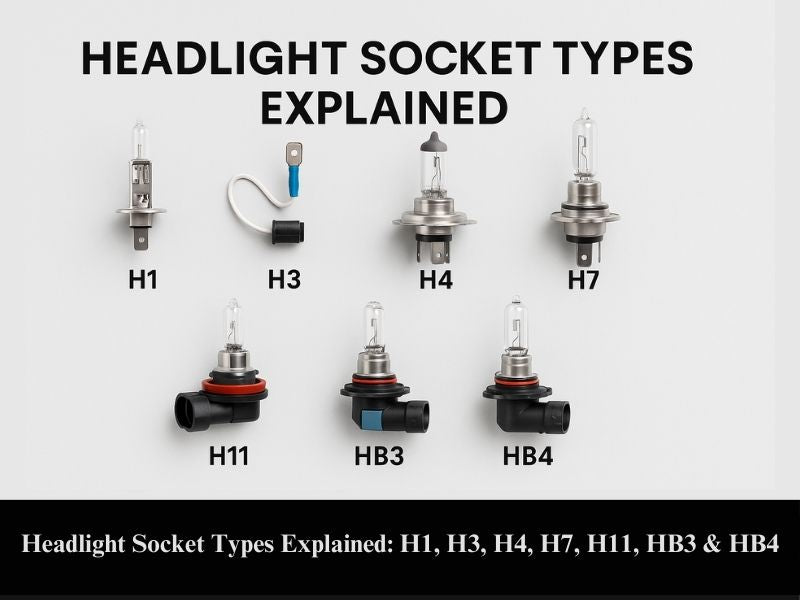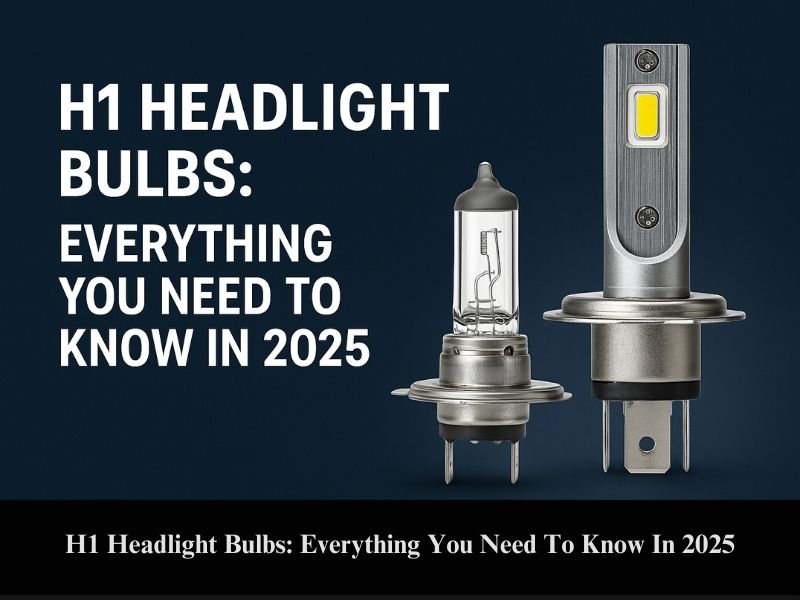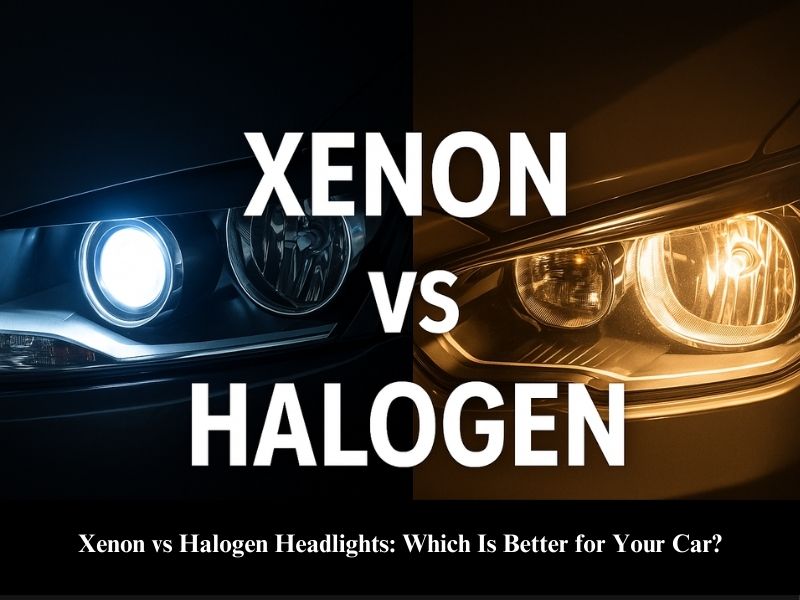You may be wondering whether xenon or halogen headlights are the better choice for your car. With so many lighting options available, it can be tough to decide which one offers the best performance, visibility, and value.
In this article, we’ll break down the pros and cons of each headlight type to help you make an informed decision. So, without further ado, let’s read on our article and find out which option suits your driving needs best.
What Are Halogen Headlights?
Halogen headlights are one of the most commonly used lighting systems in vehicles today. They operate using a tungsten filament enclosed in a glass housing filled with halogen gas, usually iodine or bromine. When electrical current passes through the filament, it heats up and emits light. The halogen gas helps extend the lifespan of the filament and maintains the clarity of the bulb over time.
Why Halogen Headlights Are So Common
Halogen bulbs have been the standard in automotive lighting for decades. Their widespread usage can be attributed to:
-
Affordability – They are cheaper to produce and replace compared to newer lighting technologies.
-
Compatibility – Halogen bulbs fit most headlight housings and are readily available in stores and auto shops.
-
Simplicity – No additional wiring or equipment is typically needed, making them easy for vehicle manufacturers and users alike.
Advantages of Halogen Headlights
-
Cost-effective: One of the cheapest headlight options on the market.
-
Widely available: You can find them almost anywhere—online or at local auto parts stores.
-
Simple installation: No need for complex upgrades or wiring; often a straightforward plug-and-play replacement.
Disadvantages of Halogen Headlights
-
Shorter lifespan: Most halogen bulbs last between 500 to 1,000 hours, requiring more frequent replacements.
-
Lower brightness: Compared to Xenon or LED, halogen produces a dim yellowish light, which may reduce visibility at night or in bad weather.
-
Higher heat production: Halogen bulbs generate a significant amount of heat, which results in energy loss and reduced efficiency.
What Are Xenon (HID) Headlights?
Xenon headlights, also known as High-Intensity Discharge (HID) headlights, are a step up from traditional halogen lighting. Instead of using a filament, these bulbs produce light by passing an electric current through a gas-filled chamber, typically containing xenon gas and metal salts. The result is a bright, white-blue light that closely resembles natural daylight.
How Xenon Headlights Work
Xenon headlights function differently from halogen bulbs in a few key ways:
-
No filament involved: Light is created through an electric arc, not a heated wire.
-
Gas discharge technology: The arc ignites the xenon gas, producing a high-intensity glow.
-
Ballast required: HID systems need a separate electronic ballast to regulate voltage during startup and operation.
-
Warm-up time: Xenon bulbs usually take a few seconds to reach their full brightness, unlike halogen which lights up instantly.
Advantages of Xenon Headlights
-
Brighter and whiter light output: Produces about 3,000 lumens, offering significantly improved visibility compared to halogen.
-
Longer lifespan: Typically lasts 2,000 to 5,000 hours, reducing how often you need to replace the bulbs.
-
Better energy efficiency: Uses less energy than halogen once fully powered, despite requiring more startup energy.
Disadvantages of Xenon Headlights
-
Higher initial cost: Xenon bulbs and their required ballasts are more expensive upfront than halogen.
-
Potential glare issues: The intense brightness can cause glare for other drivers if the system isn’t properly aligned or installed.
-
Takes time to reach full brightness: Not ideal if you need instant full light output, especially in emergency driving situations.
Comparison Among Halogen and Xenon Headlights
When deciding between halogen and xenon headlights, it helps to compare their key features side by side. Here's how they differ in several important areas:
When deciding between halogen and xenon headlights, it helps to compare their key features side by side. Here's how they differ in several important areas:
Brightness and Visibility
-
Xenon headlights offer brighter and wider illumination, making it easier to see road signs, lane markings, and obstacles at night.
-
Halogen bulbs provide adequate visibility, but the light has a warmer yellow tint, which can seem dim compared to xenon.
Energy Efficiency
-
Xenon headlights are more energy-efficient in the long run. They require a bit more power at startup but use less energy overall during operation.
-
Halogen lights consume more energy and generate more heat, making them less efficient.
Lifespan
-
Xenon bulbs generally last between 2,000 to 5,000 hours, meaning fewer replacements over time.
-
Halogen bulbs typically last 500 to 1,000 hours, so you'll need to change them more often.
Cost Considerations
-
Halogen bulbs are cheaper to buy and replace, which makes them a budget-friendly option.
-
Xenon systems have a higher upfront cost, but their longer lifespan may provide better value in the long term.
Safety and Glare
-
Xenon lights can cause glare to other drivers if they are not properly installed or aligned.
-
Halogen bulbs produce less intense light, so glare is rarely an issue, but visibility is also lower, especially in dark or rural areas.
Both halogen and xenon headlights have their strengths and weaknesses, depending on your driving needs and budget. Halogen is more affordable and easy to replace, while xenon delivers stronger visibility and longer life.
However, as headlight technology continues to advance, more drivers are starting to look beyond these two options in search of something even better, leading to the growing popularity of LED headlights.
The Rise of LED Headlights
As automotive lighting continues to evolve, LED headlights have become a popular choice for many modern vehicles. Short for Light Emitting Diode, this technology uses semiconductors to emit light when an electrical current passes through them.
Unlike halogen and xenon, LEDs don’t rely on filaments or gas to produce light, making them highly efficient and long-lasting.
What Are LED Headlights?
LED headlights are designed using compact diodes that emit light in a specific direction, offering precise and focused illumination. Their small size allows for more creative and modern headlight designs, which is why you’ll often see them in newer vehicles and high-end models. They also provide full brightness instantly with no delay.
Advantages of LED Headlights
-
Superior energy efficiency: LEDs use significantly less power than both halogen and xenon lights.
-
Longest lifespan: Many LED systems last up to 50,000 hours, drastically reducing the need for replacements.
-
Compact and versatile: Their small size allows manufacturers to design sleek and innovative lighting shapes.
-
Instant full brightness: No warm-up time. They illuminate instantly, which improves response time while driving.
-
Reduced glare potential: When properly aligned, LED lights are less likely to cause glare for other drivers compared to xenon.
Disadvantages of LED Headlights
-
Higher upfront cost: The initial cost of LED systems can be more expensive than both halogen and xenon options.
-
Complex installation: Depending on the vehicle, replacing or upgrading to LED may require specialized tools or professional installation.
Why LED Headlights Are Becoming the Preferred Choice
When compared side by side, LED headlights outperform halogen and xenon in nearly every major category, making them the top pick for many car manufacturers and drivers alike.
Let’s look at how all three technologies compare:
|
Feature |
Halogen |
Xenon (HID) |
LED |
|
Brightness |
Moderate (yellow tone) |
Very bright (white-blue) |
Bright and focused (white) |
|
Energy Efficiency |
Low |
Medium |
High |
|
Lifespan |
500–1,000 hours |
2,000–5,000 hours |
Up to 50,000 hours |
|
Warm-Up Time |
Instant |
Requires warm-up |
Instant |
|
Upfront Cost |
Low |
High |
Medium to High |
|
Glare Risk |
Low |
High (if misaligned) |
Low (if properly installed) |
|
Design Flexibility |
Limited |
Moderate |
High |
In addition, here are a few more reasons why LED headlights are quickly becoming the go-to choice:
-
Growing Adoption in Modern Vehicles: Automakers are increasingly turning to LED technology due to its performance, efficiency, and styling flexibility. Many new vehicles now come with factory-installed LED headlights, while older models are often upgraded with LED kits for improved lighting.
-
Environmental Benefits: LED headlights consume much less power than halogen and xenon, which helps reduce the vehicle’s overall energy use. Over time, this not only lowers fuel consumption in traditional vehicles but also supports better range in electric cars, making LEDs a more environmentally responsible option.
-
Enhanced Safety and Versatility: LED headlights improve visibility without creating excessive glare when correctly installed. Their instant-on capability and focused beam pattern help drivers react faster in sudden situations. Plus, LED systems can be adapted for smart features like automatic high-beams and adaptive lighting in advanced driver-assist systems.
Are There Aftermarket Options for LED Headlights?
Yes, there are many aftermarket LED headlight options available for a wide range of vehicles. Reputable brands like Morimoto, Auxbeam, Sealight, and Carifex offer LED headlight kits that cater to various car makes and models. These kits come in different styles, brightness levels, and often include features such as adaptive lighting and plug-and-play installation.
Aftermarket LED headlights are a popular choice for drivers looking to improve visibility, add a modern look, or enhance the performance of their vehicle’s lighting system. Whether you prioritize functionality, style, or custom features, there’s likely a solution that fits your needs.
When choosing aftermarket LED headlights for your vehicle, keep the following in mind:
-
Compatibility: Make sure the LED kit matches your car’s model and year to ensure proper fit and function.
-
Certifications: Look for headlights that are DOT or ECE compliant to ensure they meet legal safety standards.
-
Trusted Brands: Choose well-reviewed and established brands to ensure reliable performance and durability.
Upgrading your vehicle with aftermarket LED headlights is a smart way to improve both safety and style, all while personalizing your ride to match your preferences.
Related articles
-
Can You Replace Your Old Halogen Headlight Bulbs with LED Headlights?
-
10 Proven Tips to Choose LED Headlight Bulbs for Your Vehicle
Best LED Headlights for Your Vehicle in 2025: Top Recommendations
Upgrading your car with LED headlights is one of the most effective ways to enhance visibility, safety, and driving comfort, especially during nighttime or adverse weather conditions. Below are some of the top LED headlight options available in 2025, compatible with a wide range of vehicle makes and models.
1. Carifex Non-Flickering LED Headlights

Carifex Non-Flickering LED Headlights are designed for stable and consistent illumination, improving visibility on dark roads and in poor weather without flicker or dimming.
Key Specifications:
-
Bulb Type: LED Headlight Bulb
-
Wattage: 100W per set (50W per bulb)
-
Lumens: 10,000 lumens per set (5,000 lumens per bulb)
-
Color Temperature: 6,500K (bright white)
-
Lifespan: Up to 30,000 hours
-
Voltage: Compatible with 12V/24V systems
What’s Included:
-
2 LED headlight bulbs
-
User manual
Compatibility: Compact, fanless design makes these bulbs suitable for many vehicle types, offering a quick and reliable upgrade.
2. Carifex Pro Fit LED Headlight Bulbs

Known for their energy efficiency and strong brightness, Carifex Pro Fit LED bulbs are a top choice for drivers seeking long-lasting and high-performance lighting.
Key Specifications:
-
Bulb Type: LED Headlight Bulb
-
Lumens: Up to 7,000 lumens per set
-
Color Temperature: 6,000K (cool white)
-
Lifespan: Up to 50,000 hours
-
Power: 70W per set (35W per bulb)
-
Voltage: DC 12–24V
-
Waterproof Rating: IP68
What’s Included:
-
2 LED headlight bulbs
-
Instruction manual
-
VIP 24/7 after-sale customer support
Compatibility: Designed for a secure fit in most passenger vehicles, these bulbs are ideal for both urban commuting and longer road trips.
3. Compact LED Headlight Bulbs by Carifex

A budget-friendly yet reliable solution, Compact LED Headlight Bulbs offer solid lighting performance for drivers looking for value without compromising quality.
Key Specifications:
-
Wattage: 35W
-
Lumens: 6,000 lumens per bulb
-
Color Temperature: 6,000K (cool white)
-
Lifespan: Up to 50,000 hours
-
LED Chip: Supercharged CREE LED
-
Installation Time: Under 30 minutes
What’s Included:
-
2 LED headlight bulbs
-
Installation guide
-
VIP 24/7 after-sale customer support
Compatibility: With a plug-and-play design, these bulbs are engineered for easy installation in a variety of vehicles, offering dependable lighting with minimal effort.
No matter what type of vehicle you drive, upgrading to one of these top-rated LED headlight kits can significantly improve your night driving experience while adding a modern touch to your car’s appearance. Choose the set that fits your needs and enjoy the added confidence that comes with better visibility.
Where to Buy the Best LED Headlight Bulbs For My Vehicle in 2025
Ready to enhance your vehicle's headlights with high-performance LED bulbs? At Carifex, we provide a comprehensive selection of the latest LED lighting solutions tailored for a variety of vehicles, including LED Headlights, LED Tail Lights, LED Fog Lights, and many more.
Here’s why Carifex is your top choice for LED headlight bulbs:
-
Quality Assurance: Our LED bulbs adhere to rigorous quality standards, ensuring dependable and long-lasting performance whether you're on the highway or navigating off-road terrain.
-
Wide Selection: We offer a diverse range of designs and styles to complement your vehicle's aesthetics while fulfilling your lighting needs.
-
Competitive Pricing: Benefit from great value with our affordable pricing, making it easy to upgrade your vehicle’s lighting system without breaking the bank.
-
Customer Satisfaction: Our dedicated team is committed to providing outstanding customer service, helping you choose the ideal product and offering support with installation.
Explore our range of headlights and other LED automotive products today. Click below to visit our store and discover the perfect upgrades for your vehicle!
Final Thoughts
When it comes to choosing between halogen, xenon, and LED headlights, your decision should be based on a balance of budget, performance, and long-term benefits.
-
Halogen headlights remain popular due to their affordability and simplicity, but they fall short in brightness, efficiency, and lifespan.
-
Xenon (HID) headlights offer improved visibility and longer life but come with higher upfront costs and potential glare issues.
-
LED headlights, on the other hand, strike the best balance, as they offer superior energy efficiency, the longest lifespan, instant brightness, and minimal glare when properly installed.
As technology advances and more manufacturers adopt LEDs as the standard, they’re clearly becoming the preferred choice for both new vehicles and aftermarket upgrades. If you're looking for a reliable, modern, and energy-efficient lighting solution, LED headlights are the way forward.
Key Takeaways
-
Halogen headlights are affordable, easy to replace, and widely compatible, but they produce a dim yellowish light and have a shorter lifespan.
-
Xenon (HID) headlights offer significantly brighter illumination and a longer lifespan than halogen, though they are more expensive and can cause glare if misaligned.
-
LED headlights are currently the most advanced option, providing excellent brightness, instant illumination, high energy efficiency, and the longest lifespan(up to 50,000 hours).
-
Energy efficiency increases from halogen to xenon to LED, with LEDs using the least power and producing minimal heat.
-
Lifespan comparison: Halogen lasts 500–1,000 hours, xenon lasts 2,000–5,000 hours, while LED can last up to 50,000 hours, making it the most durable choice.
-
LED headlights offer better safety, with reduced glare risk and faster reaction time due to instant full brightness and focused beam patterns.
-
Design flexibility is highest with LEDs, enabling modern, sleek headlight styles and integration with adaptive lighting technologies.
-
Cost considerations vary: halogen is cheapest upfront, xenon is most expensive, and LED sits in the middle but may offer better long-term value.
-
LEDs are increasingly used in new vehicles and are often chosen for aftermarket upgrades due to their superior performance and aesthetic appeal.
-
Aftermarket LED options like Carifex Pro Fit and Non-Flickering models provide accessible, high-quality upgrades compatible with many vehicles.
FAQs
How do xenon and halogen headlights compare in terms of energy efficiency?
Xenon headlights require one-third less electrical power than halogen lamps while producing more light. This makes them significantly more energy-efficient despite their higher brightness.
Can I upgrade from halogen to xenon headlights?
While upgrading is possible, it typically requires installing the complete xenon system including the bulbs, ballasts, and potentially the headlamp leveling system. This makes it a more complex upgrade compared to simply replacing bulbs.
Do xenon headlights require special equipment?
Yes, xenon headlight systems include additional components such as a dynamic headlamp leveling device that reacts to acceleration and braking processes, as well as a headlamp cleaning system to ensure glare-free light.




